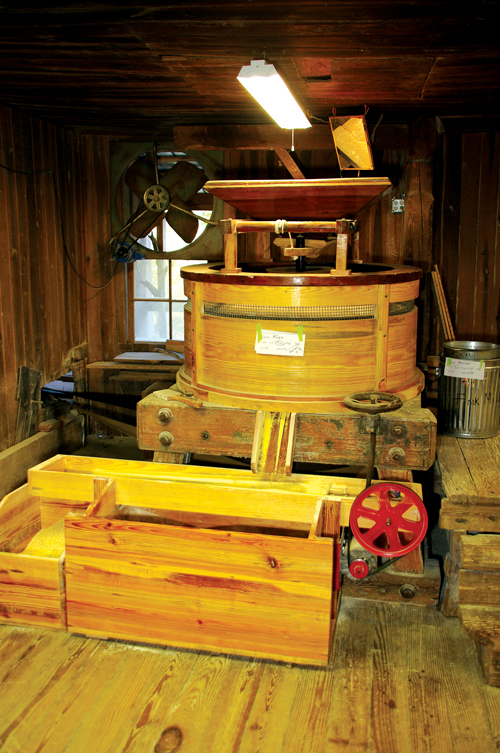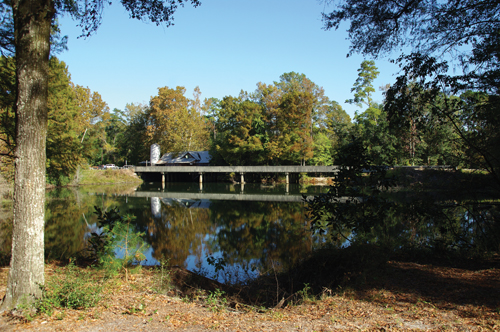Depression-era grain mill preserves a bygone way of life
The wooden floor shakes beneath your feet, and the air seems a bit heavy, thanks to the dust kicked up from the fresh-ground corn. The rhythmic metallic clinks of the machinery, which turn hundreds of pounds of dried corn into mounds of fluffy, earthy meal, ring in your mind, even after you leave.
This practice of milling grain, a technology that dates to the ancient mills that came to this country with immigrants, continues today, relatively unchanged for hundreds of years.
Members of the Fink family in southeast Alabama see themselves as protectors of this old-fashioned practice, and have operated this mill, built in 1932, since their parents bought it in the mid-1950s.
“I see this as a historical site that needs to continue to be maintained,” says Darell Fink, taking a break from running the mill on an autumn Saturday.
Finks Mill is just a half-mile north of the Florida line, a few miles east of Florala and west of Samson and a member of Wiregrass Electric Cooperative. Farmers start coming in the early morning hours and continue into the afternoon, hauling big, heavy sacks of corn (and occasionally wheat and rice) to be ground.

The mill’s four stone units can produce 2,000 pounds of corn meal each day that it operates. On this particular Saturday, there won’t be quite that much meal ground; customers may be distracted by the football games today, or perhaps the crisp fall weather.
No matter. Those who show up are here to take part in a centuries-old tradition and enjoy the camaraderie of friends and neighbors. There’s a mix of old folks and younger ones, some who’ve been coming here for decades and others who are first-timers. Some drive from out of state just to have fresh ground corn meal to take home.
“Usually every Saturday, you’ll have at least one person who’s never been here,” says Quin Fink, Darell’s younger brother who’s a mechanic by trade and maintains the mill. “It’s just a place that time hasn’t messed with much.”
Taking part in the process
The customers bring in their husked, dried corn, and upon arrival their corn is weighed on a scale that has to be almost as old as the mill itself. (And it’s still accurate; a visitor hops on the scale and proclaims that it’s the same as what he weighed at home that morning.)
A ticket is written up with the customer’s name, the amount of corn and the type of grind preferred (the mills can grind course meal, medium, fine, extra fine and grits.) The corn is then put through a sifting machine that separates out any trash, dirt or matter leftover from the harvesting process. The sifted corn is put in line for milling; on a busy day, dozens of buckets can wait to be milled.
One worker lifts a bucket of corn overhead to pour it into a large hopper, which funnels the corn into the stones for grinding. As their corn is milled, customers can scoop and bag their own fluffy meal as it falls down the chute and through a screen into the waiting wooden bin below.
This meal, unlike the stuff sold in stores, is perishable, because it retains the corn oil; modern processing strips out the oil, which is a precious commodity. But that oil gives a nutty, earthy taste to the fresh ground meal, which Darell says is a superior flavor to anything you can buy commercially.
“There’s just something about raising your own corn, knowing what’s in there, seeing it ground and bagging it yourself,” Darell says. He thinks folks today are developing an appreciation for fresh, homegrown foods. “We’re seeing a return to where people are growing their own gardens, and milling is a component of it.”
Family tradition

Quin and Darell Fink continue to operate the mill with Quin’s wife, Dolly, and their family friend Jeff Pendleton. All live close by and have dedicated most of their spare time to keeping the mill operational.
It’s no small task. “This thing is so old, it really should not work every day,” Darell says. Everything here has to be handmade – bearings, shafts, all the working parts of the stone units. For the Finks, running the mill is a matter of balance: they want it to run enough to keep all the moving parts going, but not so much that they wear out.
For those reasons, they usually run the mill only on Saturdays, beginning Labor Day weekend and on through the winter. The other six months of the year, they’re constantly doing maintenance work: Disassembling the stone units, doing woodwork, inspecting the bearings and the belts, doing maintenance to the gates that hold back the water. “Whatever little money we get, we basically just spend it on the mill to keep it going,” Darell says.
Old ways
Today, farmers drive pickup trucks, not wagons, to the mill to have their grains ground. But beyond the transportation involved, the rest of the experience is much the same as it was 80 years ago.
A trip to the mill was both a necessity as well as an opportunity for social networking, says Gregory Jeane, Ph.D., who has extensively studied Southern grist mills. The heyday of milling in Alabama, and much of the eastern U.S., was from 1850 to 1910, Jeane says; in 1880, more than 800 flouring and grist mills were widely scattered in the state, meaning most families lived in close proximity to a mill.
Mills were often selected to be post offices, and larger mills often had ancillary operations, such as a lumber mill, a blacksmith shop, a general store and would serve as a voting location, Jeane says.
Such activities meant the mill was a social center for rural communities, a place for adult men to discuss crops, livestock and politics. (“Going to the mill” was fundamentally a male outing, though sometimes the whole family would go along.)
The number of working mills in Alabama today has dwindled to a handful, but at Finks Mill, the activity is much the same. The customers place their orders and spend the time waiting in conversation with neighbors and strangers. The camaraderie, as much as the cornmeal, is the draw.
For the Finks, the customers become like family. “You get to where you’re attached to these people,” says Dolly Fink, Quin’s wife.
Some of these folks have been coming here for decades, and some even remember the mill when it was new, Quin says. And the family plans to keep it going as long as they can.





